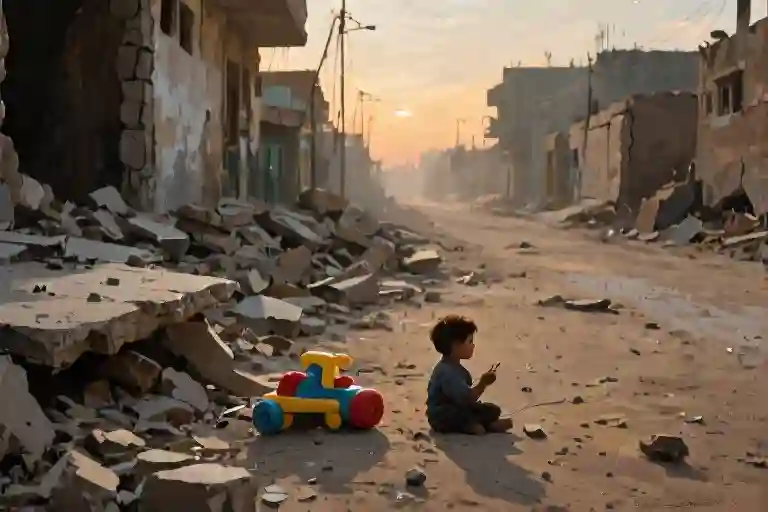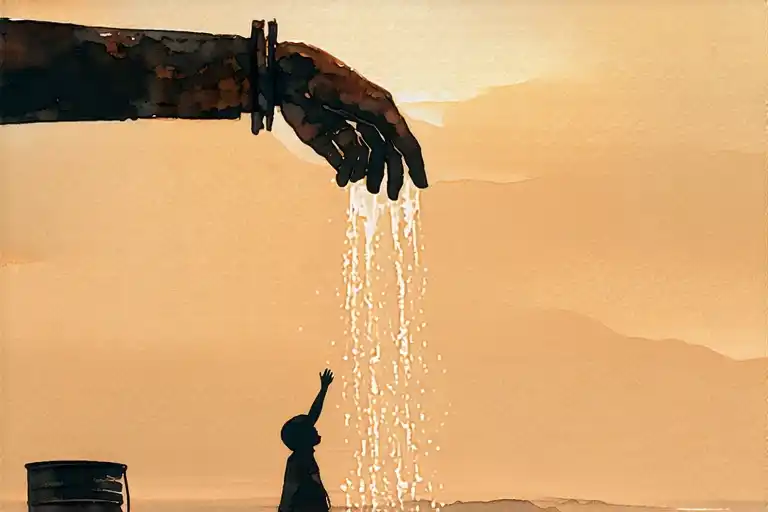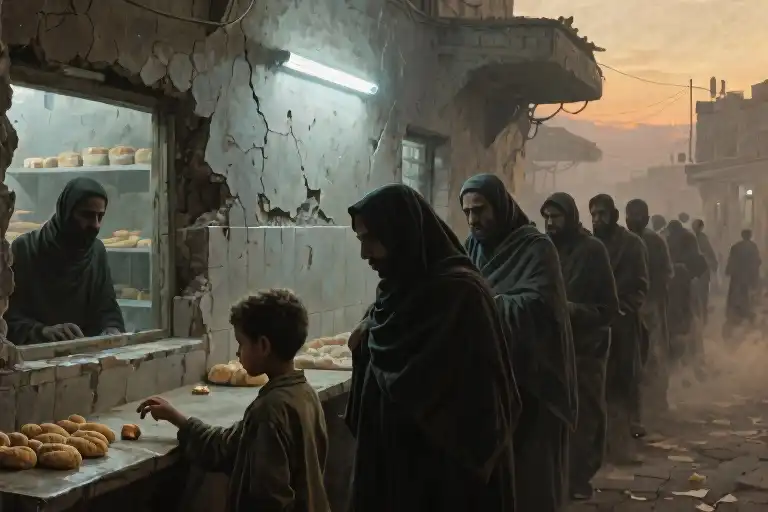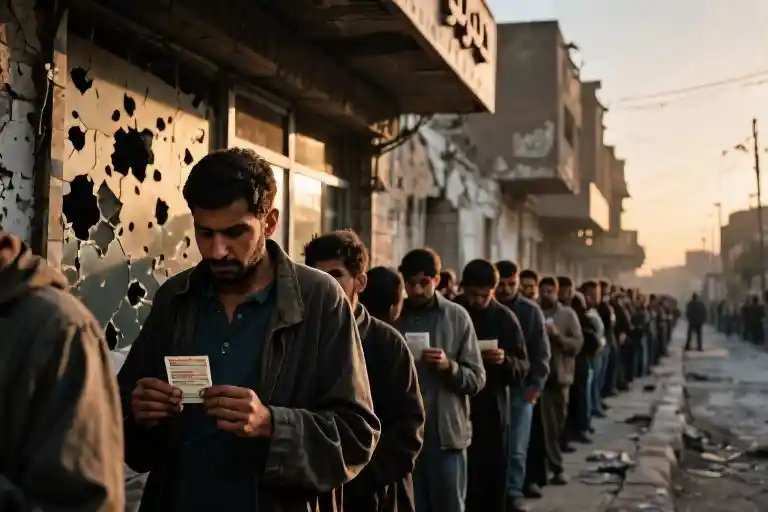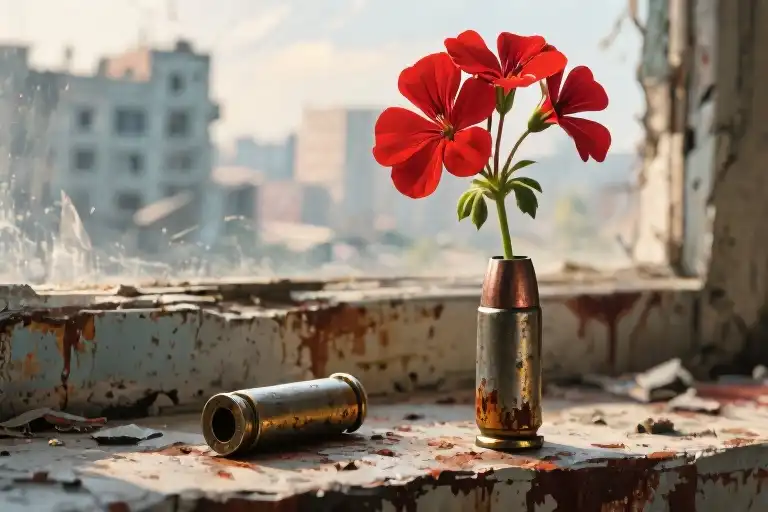The explosions have stopped. For now. My ears still ring with the aftershocks of sound, my pulse throbbing in my throat like a trapped bird. Ten minutes of silence—fifteen maybe?—but the air feels heavier than before, thick with dust and unanswered questions. This isn’t peace. It’s the unbearable lightness of waiting for the next strike.
In Gaza, we measure time differently. Not in hours or days, but in the spaces between sirens. The pause after bombardment is its own kind of violence. Your muscles stay coiled, your breath shallow, as you mentally map the distance of each explosion. Was it three streets away or five? Did it hit the bakery where your cousin works? The school where your neighbor’s children should’ve been safe? You become a mathematician of catastrophe, calculating probabilities with trembling hands.
Children here learn silence before they learn algebra. I’ve seen six-year-olds pause mid-game, heads cocked like small radars, interpreting the quality of quiet. They know the difference between ‘temporary’ and ‘over’ long before they understand fractions. When the playground goes still, they don’t celebrate—they inventory exits. This is what passes for normalcy: a generation that associates laughter with risk.
The smells tell their own story. Acrid smoke from burning buildings. The metallic tang of ruptured water pipes. Beneath it all, the sour scent of fear that no amount of washing removes. Sometimes, when the wind shifts, you catch ghosts of ordinary life—fried onions from a kitchen still standing, jasmine blooms stubbornly pushing through cracked concrete. These fleeting moments hurt the most.
We’ve developed rituals for these pauses. Check your phone for messages, if the network exists. Count the faces around you. Re-tie your shoes in case you need to run. The most practiced among us can shower in ninety seconds flat, always fully clothed underneath. Survival here isn’t about heroics—it’s about the mundane adjustments that let you endure another hour.
Outside, the world talks of ceasefires measured in days. We measure ours in heartbeats. That ten-minute silence? It’s already slipping away. Somewhere beyond the rubble, a drone’s persistent hum reminds us: this is just the comma in a sentence nobody chose to write.
The Anatomy of a Pause
Ten minutes of silence. That’s all it takes for the body to begin its cruel inventory. First the ears – still ringing with phantom explosions, as if the soundwaves carved permanent grooves in the eardrums. Then the hands, trembling not from fear but from adrenaline with nowhere to go. The tongue probes for missing teeth you didn’t realize were knocked loose until this unnatural quiet exposed them.
In Gaza, we measure safety in these absurd equations: If the pause lasts three minutes, maybe it’s safe to check on the neighbors. Five minutes could mean running for water. Seven minutes and the bravest might venture to assess the damage. But everyone knows the real calculation – the longer the silence stretches, the heavier the next strike will land.
My neighbor Um Youssef taught me this when I was twelve. She’d stand in her doorway with a stopwatch during bombardments, calling out intervals like a macabre weather report. ‘Three minutes forty seconds last round,’ she’d announce, as if this data could somehow armor us against the next impact. Twenty years later, I catch myself doing the same thing – counting seconds between concussions, assigning arbitrary safety values to meaningless numbers.
What no one mentions about surviving bombardment is how the body becomes its own early warning system. Muscles remember the particular vibration preceding an airstrike – that specific frequency humming through concrete before the world turns white. The skin develops its own vocabulary, interpreting pressure changes in the air as sentences: That tingle means incoming, that prickle suggests distance.
Children adapt fastest. Little Mariam from the third floor can distinguish between drone models by their buzz, predicting which ones will linger and which will deliver payloads. The boys play a horrible game they call ‘Counting the Dead’ where they guess casualty numbers based on explosion types. No one corrects them anymore. This is their normal.
Sometimes, in these pauses, I try to remember what silence used to mean. Before it became just another kind of screaming. Before the absence of noise became more terrifying than noise itself. There’s a particular quality to postwar quiet – it doesn’t soothe, it interrogates. Every second whispers: Will you make it to eleven minutes? To twenty? To dawn?
The math never works in our favor. Eventually, the humming always returns.
Children Who Forgot How to Cry
The ambulance sirens sound different here. Twelve-year-old Ahmed demonstrates this by pushing his toy car across the floor, alternating between two types of wails – one high-pitched and urgent for ‘normal emergencies’, another lower, shuddering sound for ‘when the drones are still watching’. His small hands tremble slightly as he explains the rules of his game, developed through three wars already in his short lifetime. The toy ambulance always takes the back roads, he tells me, because that’s what real drivers do to avoid surveillance.
In another classroom down the road, teacher Marwa keeps a notebook of things children say during air raids. The most haunting entry reads: ‘Miss, when will the angry thunder stop?’ For these children, who’ve never experienced a true storm, the vocabulary of violence has overwritten nature’s lexicon. They speak of ‘iron birds’ instead of drones, ‘fire rain’ instead of missiles, their tiny bodies flinching at sudden noises even during rare calm days.
What unsettles me most isn’t their fear – it’s their precision. Eight-year-old Lina can identify munition types by sound alone, her small face lighting up when she correctly names an F-16’s distant roar. She draws pictures of winged ambulances that look suspiciously like combat drones, the lines between rescue and danger blurred in her crayon strokes. UNICEF reports say 90% of Gaza’s children show symptoms of toxic stress, but the numbers don’t capture how trauma manifests – in the way they incorporate war into play, how they’ve developed an entire shadow vocabulary to describe their shattered normalcy.
During what international observers call ‘humanitarian pauses’, I watch children perform the most heartbreaking calculus. They’ve learned to interpret intervals between explosions like meteorologists reading weather patterns – fifteen minutes means time to fetch water, thirty might allow a trip to what remains of the playground. Their laughter during these respites isn’t joy but survival, tiny bodies practicing the art of pretending everything’s fine because the alternative is unthinkable.
The silence between bombardments doesn’t bring relief but sharper fear. Small hands clutch at adults’ shirts, not asking ‘Is it over?’ but ‘How long until the next one?’ When the humming of drones returns – that relentless sound like a mosquito inside your skull – I’ve seen children as young as five stop crying entirely. They simply cover their ears and wait, their eyes holding the weary patience of elderly survivors. This is what living through multiple wars does: it teaches even the youngest that tears won’t stop the bombs, so why waste them?
The Language of Silence
The hiss comes first—a sharp exhale of fractured pipes under rubble. It’s not the sound of danger itself, but the aftermath speaking in metallic whispers. In Gaza, we’ve learned to read silence like braille. The drone’s hum three streets over means the surveillance cycle has restarted. The absence of generators at dawn signals another fuel blockade. These are our street signs now.
Before the wars, silence had different dialects. The call to prayer would dissolve into the clatter of coffee cups in the market. Wedding processions trailed drumbeats and ululations that bounced off limestone walls. Old men playing shesh besh in alleyways punctuated their games with throaty laughter. Those sounds didn’t disappear all at once, but faded like colors in sun-bleached fabric—so gradually we only noticed their absence when the new silences took hold.
Children here develop an eerie auditory precision. My neighbor’s daughter once mistook an ambulance siren for an ice cream truck’s jingle—her brain rewiring trauma into something survivable. Others categorize explosions by their pitch: the dull thud of a mortar means it landed in the sea, the high-pitched crack signals a nearby impact. They play ‘guess the bomb’ like children elsewhere might identify bird calls.
The most sinister silence lives between midnight and 3 AM. That’s when the drones switch to night vision and the buzzing takes on a different texture—like a mosquito evaluating where to land. We lie awake measuring the gaps between power outages, each flicker of electricity feeling like borrowed time. Sometimes I catch myself holding my breath during these pauses, as if my stillness could make me invisible to the machines overhead.
UN reports call it ‘acoustic trauma’—the way constant noise pollution alters brain chemistry. But they never mention how the absence of certain sounds carves its own wounds. The missing clang of the bread vendor’s cart at 5 AM tells us another baker has fled. When schoolyard shouts don’t resume after an attack, we know which classrooms took direct hits. Our ears have become seismographs, registering losses in decibels and silences alike.
Occasionally, a ghost of the old sounds resurfaces. Last winter, a boy on our street whistled a folk tune his grandfather taught him. For three minutes, the alley held its breath—not in fear, but in fragile reverence. Then the drones returned, and we all remembered where we were. That’s the cruelest grammar of war: it doesn’t just steal the present, but colonizes memory until even nostalgia becomes a minefield.
Calculating Survival
The arithmetic of war is different here. It’s not about counting casualties or measuring destruction—those numbers lose meaning after a while. Instead, we measure time in the spaces between explosions, calculating survival in minutes and seconds. Fifteen minutes of silence means you might risk boiling water. Thirty could mean checking on a neighbor. An hour? That’s when people emerge like cautious animals after a storm, blinking at the sunlight, wondering if this pause will last.
My notebook has become a ledger of these intervals. March 12: 22 minutes between strikes—just enough time to bury the dead from the previous attack. April 3: Three separate 8-minute pauses—the exact duration needed to walk children to the makeshift school and back. We’ve developed an unwritten calculus where every decision depends on this fragile equation: How long has it been quiet? How long might it stay that way?
International news speaks of ceasefires in broad strokes—12 hours, 3 days, a week. But on the ground, we live in smaller increments. A ‘humanitarian pause’ that makes headlines means nothing when you’re measuring safety in the time it takes to wash clothes or dig through rubble. The disconnect between diplomatic timetables and our lived reality would be laughable if it weren’t so deadly.
Certain routines have adapted to this rhythm. Laundry happens in 10-minute bursts between bombardments. Meals are cold foods that require no cooking—no one risks lighting a stove when the gas pipes might be next. Even sleep follows new rules: shoes stay on, bags stay packed by the door, children learn to wake and move without crying.
There’s a particular cruelty to this mathematics. The intervals teach you to hope just enough to feel the loss when the explosions resume. That 45-minute stretch last week? Long enough to almost believe the fighting had stopped. Long enough to let your shoulders relax. Long enough for the next blast to shatter something deeper than buildings.
The most skilled among us have developed an eerie precision. Uncle Mahmoud can tell the difference between incoming and outgoing artillery by the sound. The girls next door have mapped which walls provide cover from which directions. We’ve all become experts in this terrible geometry, measuring angles of impact, calculating trajectories of falling debris.
Sometimes I wonder what would happen if we applied this intensity of calculation to peace. If we measured the gaps between acts of kindness instead of violence. If we timed how long a child could play without flinching at loud noises. But that’s not the world we live in—not yet. So for now, we keep counting the minutes between explosions, turning survival into a numbers game no one should have to play.
When the Humming Returns
The children are the first to hear it. A collective flinch moves through the room like an electric current—small hands fly up to cover ears before conscious thought catches up. That familiar metallic whine in the distance, the sound of a mosquito grown to monstrous proportions. The drones are back. The ten minutes of silence have expired.
You can measure the psychological toll by watching their bodies. Seven-year-old Mariam doesn’t cry anymore; she simply folds herself into the corner where two walls meet, pressing her forehead against the concrete as if trying to disappear into the structure itself. Twelve-year-old Omar has developed a system—he counts the seconds between each buzzing pass overhead, whispering numbers like a macabre nursery rhyme. These are children who can distinguish between an F-16 and a reconnaissance drone by sound alone, who know the difference between ‘loud-and-far’ versus ‘quiet-and-dangerously-close’.
Adults perform their own rituals. Someone reignites the stove to boil what’s left of the thyme leaves—not because anyone wants tea, but because the act of holding a warm cup gives trembling hands something to do. A neighbor methodically rearranges the same stack of blankets for the third time. We’ve all developed this kinetic vocabulary, these small, useless motions that say what we can’t: I am still here. For now.
The arithmetic of survival becomes instinctual. If the humming started after exactly 14 minutes of quiet, we might get 14 more when they leave. That’s enough time to:
- Send the fastest runner to check on Auntie Yasmin’s collapsed balcony
- Trade our remaining cigarettes for two liters of brackish water from the tanker
- Let the children use the makeshift toilet without screaming at them to hurry
International news will later call this a ‘humanitarian pause.’ On the ground, we call it al-hisaab—the calculation. Every decision gets filtered through this brutal math: Is risking a trip to the bombed-out pharmacy worth the chance of being caught in the next strike? Should we eat the last tin of beans now or save it for when the explosions come at night? The equations never end.
Three things you can do when the statistics overwhelm you:
- Listen to the children’s metaphors—When they describe drones as ‘angry bees’ or missiles as ‘sky rocks,’ they’re creating a language to process the unprocessable. Share these phrases. They reveal more than any casualty report.
- Demand acoustic accountability—Ask journalists to publish the decibel levels of bombardment alongside death tolls. A 120dB explosion isn’t just ‘loud’; it’s permanently damaging young ears within a 3km radius.
- Sponsor a trauma notebook—Local psychologists are teaching kids to draw their nightmares rather than relive them. $5 provides a sketchbook and colored pencils—weapons against the memories.
The humming never truly leaves. Even in rare quiet moments, it lingers in the inner ear, a phantom vibration at the edge of hearing. You’ll see people startle at harmless sounds—a refrigerator’s hum, a child’s toy helicopter—their bodies reacting before their minds can intervene. This is what occupation sounds like long after the bombs stop: an entire population conditioned to flinch at their own heartbeat.
Data point to embed: UN reports show 91% of Gaza children exhibit symptoms of toxic stress—a condition normally found in combat veterans. [Source: OCHA 2023]*
When the Humming Returns
The drone’s hum creeps back into the silence like an unwelcome guest. You can feel the children tense before you hear it—small hands instinctively rising to cover ears that have learned too much too soon. It’s not the sound itself that terrifies, but what it represents: the cycle restarting, the fragile pause collapsing, the arithmetic of survival resetting to zero.
In Gaza, we measure time differently. The world talks about 72-hour ceasefires while we count 15-minute windows to fetch water. International observers debate ‘humanitarian pauses’ as we teach toddlers to distinguish between artillery fire and airstrikes by sound alone. There’s a cruel irony in how our children have become connoisseurs of explosions, their ears more finely tuned than any bomb-sniffing technology.
I once watched a group of kids playing ‘ceasefire’—a game where they’d freeze mid-motion whenever someone shouted ‘pause,’ their small bodies trembling with the effort of absolute stillness. The winner was whoever held position longest without blinking. No one explained the rules to them; they’d absorbed the ritual through lived experience, turning trauma into playground ritual as children do.
UNICEF says 85% of Gaza’s children now show war trauma symptoms. The statistic floats through aid reports and UN resolutions, but here it wears the face of my neighbor’s daughter who hums constantly to drown out phantom explosions, of the boy who builds ‘safe houses’ from biscuit wrappers. These aren’t cases in a study; they’re children who’ve forgotten what uninterrupted sleep sounds like.
That returning drone hum carries more than surveillance equipment—it carries the weight of interrupted childhoods, of birthdays celebrated in basements, of math lessons that include calculating blast radii. The international community calls it ‘low-intensity conflict.’ We call it Tuesday.
So what now? The data exists. The stories are documented. The question isn’t whether the world knows, but whether it cares enough to:
- Amplify local voices through #SilenceInGaza instead of speaking for us
- Fund mental health programs that address intergenerational trauma
- Pressure decision-makers to stop measuring peace in hours when children need lifetimes
Ten minutes of silence shouldn’t be a luxury. The real test of humanity isn’t how we act during explosions, but what we do between them.

